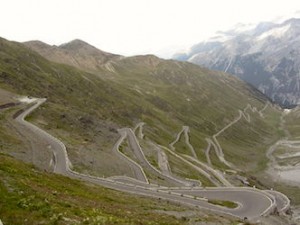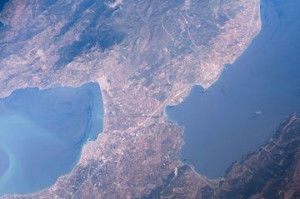There is one kind of ramp I absolutely love, except when I’m using it, in which case I absolutely hate it. That ramp is the switchback.
Anyone who’s done much mountain driving learns to hate switchbacks, even though they’re some of the most cost-effective engineering tricks we have in the mountains. (Much, much cheaper than tunnels, that’s for sure.) Truckers especially hate them. I’ve known some who will go hours out of their way to avoid them. I think gearheads are the only ones who enjoy them.
 One of the craziest examples of the breed is the Stelvio Pass in Italy. It’s one of the highest roads in the Alps and has 75 switchbacks. Seventy-five! Not a road you want to drive fast on, or even drive on at all if you can help it. Apparently, it’s so dangerous during the winter and spring that they close it completely during those seasons.
One of the craziest examples of the breed is the Stelvio Pass in Italy. It’s one of the highest roads in the Alps and has 75 switchbacks. Seventy-five! Not a road you want to drive fast on, or even drive on at all if you can help it. Apparently, it’s so dangerous during the winter and spring that they close it completely during those seasons.
Of course, being dangerous, gearheads flock to it. That British car show everyone likes, “Top Gear” (I don’t watch that show anymore after what they said about the F150), declared it the greatest driving road in the world. (Or at least in Europe. Have you seen the pictures of the crazy roads they have in the mountains in India?)
The Italian bicycle Grand Tour frequently goes through Stelvio Pass. (The Giro d’Italia, sister race to the Tour de France. I try to catch all three of the Grand Tours when I can.) Thousands and thousands of cyclists ride through Stelvio Pass every year.
It’s easier to find info on battles fought at the pass than it is to find anything beyond basic info on its construction or maintenance, but that’s pretty constant. Historians are obsessed with wars, despite the fact that construction and architecture affect us way more.
I’m working on persuading Maggie on this European vacation bit but, as carsick as she gets, I don’t think that Stelvio Pass will be on the itinerary.
 The Diolkos, built by the ancient Greeks, was half ramp, half causeway. It was used to transport ships across the Ithmus of Corinth, saving them a dangerous sea voyage. The ancient Greeks actually dragged the ships overland on it. (You’d think a canal would be easier to use, but canals are a lot harder to build and maintain.) Huge teams of men and oxen would have pulled the boats and cargo across it in about three hours per trip.
The Diolkos, built by the ancient Greeks, was half ramp, half causeway. It was used to transport ships across the Ithmus of Corinth, saving them a dangerous sea voyage. The ancient Greeks actually dragged the ships overland on it. (You’d think a canal would be easier to use, but canals are a lot harder to build and maintain.) Huge teams of men and oxen would have pulled the boats and cargo across it in about three hours per trip. With ramps, friction is the biggest variable left out; it’s a real pain to calculate. Often, teachers will just do the math with an idealized, frictionless ramp. Makes it really easy for students to figure out but gets a little ridiculous if you try to think about actually trying to use the thing—pure slapstick, really, and slapstick is one kind of humor you don’t want in the workplace.
With ramps, friction is the biggest variable left out; it’s a real pain to calculate. Often, teachers will just do the math with an idealized, frictionless ramp. Makes it really easy for students to figure out but gets a little ridiculous if you try to think about actually trying to use the thing—pure slapstick, really, and slapstick is one kind of humor you don’t want in the workplace. Well, come the day he was to test out the idea, it turns out I’d taught him with the idealized frictionless ramp model. That should have resulted in a mess on its own but, luckily for me, his big mistake had nothing to do with my assistance.
Well, come the day he was to test out the idea, it turns out I’d taught him with the idealized frictionless ramp model. That should have resulted in a mess on its own but, luckily for me, his big mistake had nothing to do with my assistance. Anyhow, ramps at different gravity levels: generally speaking, they’re much more useful at the higher ones. If you’re in zero g, just floating around, a ramp is going to be pretty pointless. As gravity gets higher, though, more and more solutions for bridging vertical distances (or, as I prefer to call it, going up and down) become infeasible.
Anyhow, ramps at different gravity levels: generally speaking, they’re much more useful at the higher ones. If you’re in zero g, just floating around, a ramp is going to be pretty pointless. As gravity gets higher, though, more and more solutions for bridging vertical distances (or, as I prefer to call it, going up and down) become infeasible. As far as I know, there’s only one book where a ramp saves the day, and that’s
As far as I know, there’s only one book where a ramp saves the day, and that’s  Those are runaway truck ramps, and they’re for semis whose brakes have blown.
Those are runaway truck ramps, and they’re for semis whose brakes have blown. Another version uses sand to absorb all the momentum: semi tires are big, but not big enough to take a semi through sand. The problem with sand ramps is that the semis have a tendency to flip on them.
Another version uses sand to absorb all the momentum: semi tires are big, but not big enough to take a semi through sand. The problem with sand ramps is that the semis have a tendency to flip on them.